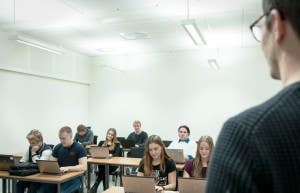Bright Ideas for Classroom Lighting

When looking into lighting, studies tend to focus on the effect on adults. However, there have been some interesting recent studies on how lighting affects children, focusing especially on an educational setting. The results appear to show that lighting, among other factors, can really influence and possibly boost pupil performance.
What can lighting affect?
Research suggests lighting can affect many different areas in children such as:
- Concentration
- Attendance
- Alertness
- Academics
- Dental Health (yes, seriously!)
- Physical Growth
Many of these are still being investigated but it is not too difficult to suppose that if light can boost adult motivation and cognitive powers, then the same effect will be seen in children. Some of these effects will also play into each other, as if children are more alert in their classes, they are more likely to concentrate and this will improve their academics.
Different Types of Lighting that can be used in a Classroom Setting
Static Lighting is lighting that has a constant colour temperature throughout the day. This is the light that is typically used in many schools, with a simple on-off switch.
Dynamic Lighting is lighting which changes throughout the day to suit different lighting needs. It contains four different types of lighting for different situations:
- Standard is for regular activities and lessons, and is set at between 3000-4000K.
- Energy lighting is for the start of the day and after lunch to wake the class up, and is set at about 12000K.
- Focus lighting is for challenging tasks such as exams or tests which require periods of concentration, and is set at about 6500K (similar to daylight).
- Calm lighting is for both independent and collaborative tasks, and for the end of the day, and is set at around 2900K.
This is beginning to be trialled in some schools but is still seen as being a while away from becoming the norm. Also, these colour temperatures are only approximate and can change slightly depending on the type of lights used.
Recent Research
Static Lighting
Results from several studies for this type of lighting show that when it is set brighter (500 lux), it is more beneficial for reading, writing, and maths, than when it was set at Standard (300 lux).

There was also evidence that a more neutral-white colour had a more positive effect than a warmer colour tone in both attendance, alertness and academics.
Dynamic Lighting
Some studies have shown that this sort of lighting in classrooms can improve student well-being and decrease restlessness and aggressive behavior.
The results of three Dutch studies by Sleegers, Moolenaar, Geltzka and van der Zanden also point towards lighting being a key factor in pupil’s concentration. After various experiments, it was concluded that the Focus lighting did improve concentration and less errors were made in the tests set to pupils under this lighting.
Following the Swedish Example?

Lighting changes have already been implemented and experimented with in different schools.
One of the most recent examples came into the news earlier this year (2015). Dragonskolan secondary school in the northern city of Umeza, Sweden has invested in bright lights in seven of their classrooms, in an attempt to help students and teachers battle the long and dark winters the country faces. In December, sometimes there is as little as 45 minutes of daylight, and this causes a multitude of problems, from low attendance to poor concentration. The bright lights have been installed in order to kick-start the student’s day, as it suppresses the sleep hormone melatonin, meaning that they can put more effort into their work, rather than into keeping their eyes open. Only time will tell if this does in fact help, but for the most part, student seem to be reporting feeling more energised and motivated.
What Next?
More research is still being done and it needs to continue for us to know more about how to light our classrooms better. However, this research suggests there could be some improvements that can already be made.
Upgrading to brighter lighting, such as using LED lights or Compact Fluorescent lights, which are available as bulbs, tubes and panels, should show some improvement in academics and attendance.
Also finding a way for teachers to have more control over their lighting would mean that they could help tailor the environment to different classes and different tasks to suit both their and the children’s needs. This could be achieved using a dimmable LED system which could be used to see if this is practical in a school situation, before attempting to bring in more advance technology.
Find out more about upgrading the lighting in a classroom or entire school by calling LampShopOnline on 0113 8876270 or email sales@lampshoponline.com.
Further Resources
For more about the Dragonskolan story: http://www.bbc.co.uk/news/health-31297302
If you wanted to know more about the research study talked about in this article: How lighting affects students' concentration.
Published 2015/07/13
